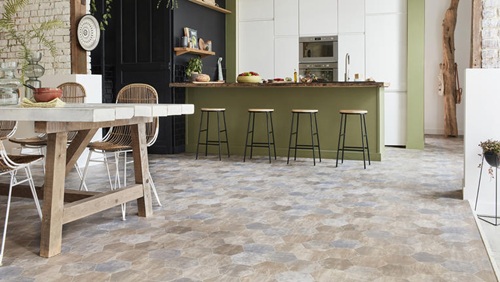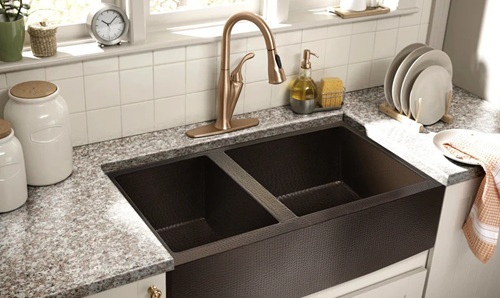When it comes to designing or remodeling a kitchen, flooring is one of the most important choices you’ll make—both in terms of style and practicality. Vinyl flooring has become an increasingly popular choice for kitchens in recent years thanks to its affordability, durability, and wide range of design options. But like any material, it comes with its strengths and weaknesses.
Let’s explore the pros and cons of vinyl flooring in the kitchen, helping you decide whether it’s the right option for your home.

🧱 What Is Vinyl Flooring?
Vinyl flooring is a synthetic flooring material made from polyvinyl chloride (PVC), often layered with fiberglass and coated with a wear-resistant surface. It is available in three main types:
- Sheet Vinyl – Comes in large rolls, seamless installation.
- Vinyl Tiles – Mimics ceramic or stone tiles.
- Luxury Vinyl Plank (LVP) – Designed to imitate hardwood flooring.
Modern vinyl floors, especially LVP and LVT (luxury vinyl tile), use advanced printing technologies to achieve highly realistic textures and patterns.
✅ Pros of Vinyl Flooring in the Kitchen
1. Highly Water-Resistant and Waterproof Options
Vinyl flooring is moisture-resistant by nature, and many luxury vinyl options are completely waterproof, making them ideal for kitchens where spills, splashes, and humidity are common.
Pro Tip: Choose “100% waterproof” LVP if your kitchen sees frequent liquid exposure.
2. Durable and Scratch-Resistant
Vinyl flooring is built to withstand everyday kitchen abuse—dropped utensils, dragged chairs, foot traffic, and pets. The top wear layer protects against scratches, dents, and stains, especially in premium vinyl products.
Fact Check: Good-quality vinyl flooring lasts 10–20 years, and some high-end types can last even longer with proper care.
3. Comfortable Underfoot
Compared to tile or hardwood, vinyl feels softer and warmer, making it more comfortable for long periods of standing while cooking or cleaning. Some types include a foam or cork backing for extra cushioning and sound absorption.
4. Affordable and Budget-Friendly
Vinyl is one of the most cost-effective kitchen flooring options.
Average Installed Cost (Per Sq. Ft.):
- Standard Sheet Vinyl: $1–$3 (₹100–₹250)
- Luxury Vinyl Plank (LVP): $2–$7 (₹200–₹600)
Compared to hardwood or stone, vinyl is significantly cheaper in both material and labor.
5. Variety of Styles and Designs
Modern vinyl flooring comes in a wide range of colors, finishes, and patterns that mimic wood, stone, ceramic, concrete, and even abstract artistic designs.
Design Note: You can create the look of a rustic farmhouse, sleek modern kitchen, or cozy cottage using the right vinyl plank or tile.
6. Easy to Clean and Maintain
Vinyl floors are low-maintenance. Simply sweep regularly and mop with a damp cloth or mild cleaner to keep them looking fresh.
No waxing, no sealing, no special treatments.
7. Easy DIY Installation
Many vinyl flooring types—especially click-lock LVP—are designed for DIY installation, which can save hundreds in labor costs. Even sheet vinyl is relatively easy to install with basic tools and preparation.
❌ Cons of Vinyl Flooring in the Kitchen
1. Not as Durable as Stone or Hardwood
While durable, vinyl is still less resilient than natural materials. Heavy appliances, sharp objects, or dragging furniture can puncture or gouge vinyl surfaces.
Warning: Damage to vinyl is often not repairable—you may have to replace the affected section or entire plank.
2. Can Fade with Prolonged Sun Exposure
Some vinyl floors can discolor or fade when exposed to direct sunlight over time, especially cheaper varieties without UV-resistant coatings.
Tip: Use curtains, blinds, or UV window film to protect your floors if your kitchen gets a lot of sun.
3. Environmental Concerns
Vinyl is made from synthetic, petroleum-based materials, and while many brands now offer low-VOC (volatile organic compound) products, it’s not biodegradable or recyclable.
Fact: Some eco-conscious homeowners avoid vinyl for environmental reasons.
4. Surface Can Feel Too Soft or “Plastic-Like”
Though comfortable, vinyl flooring can feel less “authentic” than hardwood or tile. Cheaper vinyl can have a noticeable plastic feel or appearance, which may not appeal to homeowners looking for a luxury or high-end look.
5. Subfloor Prep is Critical
Vinyl will telegraph imperfections from the subfloor below—meaning bumps, cracks, or holes can show through the surface over time. Subfloor leveling is often required before installation.
Pro Tip: Spend time prepping the base for a smoother, longer-lasting result.
⚖️ Vinyl Flooring vs Other Kitchen Flooring Options
| Feature | Vinyl | Laminate | Tile | Hardwood | Engineered Wood |
| Water Resistance | Excellent | Moderate | Excellent | Poor (unless sealed) | Moderate |
| Comfort Underfoot | High | Moderate | Low | Moderate | Moderate |
| Durability | Moderate–High | Moderate | Very High | High | High |
| Installation Ease | Easy (DIY-friendly) | Easy | Harder | Harder | Moderate |
| Maintenance | Very Low | Low | Moderate | Moderate–High | Moderate |
| Style Variety | High | High | Moderate | High | High |
| Price Range | Low–Moderate | Low–Moderate | Moderate–High | High | Moderate–High |
| Eco-Friendliness | Low | Moderate | High | High | Moderate |
🛠️ Tips for Using Vinyl Flooring in the Kitchen
- Choose Waterproof Vinyl: Especially near sinks, dishwashers, and refrigerators.
- Add Furniture Pads: Prevent scratches from chairs and stools.
- Use Entry Mats: Protect high-traffic areas from grit and moisture.
- Avoid Harsh Chemicals: Stick to mild detergents and avoid bleach or abrasive cleaners.
- Acclimate Before Installation: Let planks adjust to room temperature and humidity for 48 hours.
🏁 Is Vinyl Flooring Right for Your Kitchen?
✅ Choose Vinyl Flooring If:
- You want an affordable, low-maintenance option.
- Your kitchen is prone to spills or water exposure.
- You prefer DIY installation or want a quick renovation.
- You enjoy design flexibility with realistic wood or stone looks.
- You need something that’s comfortable and pet/kid-friendly.
❌ Avoid Vinyl Flooring If:
- You’re seeking eco-friendly or natural materials.
- You want flooring with decades of refinishing potential (like hardwood).
- Your kitchen faces intense heat or direct UV light without window protection.
- You prefer luxury texture and feel underfoot.
🧾 Final Verdict
Vinyl flooring in the kitchen is an excellent option for homeowners who value affordability, style variety, water resistance, and ease of care. It offers a practical balance between durability and design, making it a great fit for busy households, rental properties, or anyone seeking a quick upgrade.
While it may not have the prestige of natural hardwood or the ruggedness of tile, vinyl is a reliable, attractive, and functional choice that fits almost every kitchen style and budget.

